Sports recovery is a critical component of any training regimen, allowing athletes to maximize performance, prevent injuries, and ensure longevity in their sports careers. Effective recovery strategies address the physical and psychological demands of training and competition, helping athletes return to peak conditions more quickly. Here’s an overview of beneficial practices for sports recovery:
Active Recovery
- Low-Intensity Exercise – Gentle activities such as walking, swimming, or cycling at a low intensity can enhance blood circulation, helping to remove metabolic waste products accumulated during intense exercise.
- Stretching – Incorporating stretching or yoga can improve flexibility, reduce muscle tension, and enhance relaxation.
Nutrition and Hydration
- Proper Nutrition – Consuming a balanced diet rich in carbohydrates, proteins, and healthy fats supports muscle repair and energy replenishment. Including anti-inflammatory foods can also help reduce muscle soreness.
- Adequate Hydration – Replenishing fluids lost during exercise is crucial for recovery. Staying well-hydrated aids in nutrient transport, muscle repair, and overall bodily functions.
Sleep and Rest
- Quality Sleep – Ensuring adequate sleep is paramount for recovery, as many physiological repair processes occur during sleep. Aim for 7-9 hours per night, and consider naps for additional rest.
- Scheduled Rest Days – Incorporating scheduled days off from training allows the body and mind to recover fully. These days are critical for preventing overtraining and reducing the risk of injury.
Cold and Heat Therapy
- Cold Therapy – Ice baths or cryotherapy can reduce inflammation, and muscle soreness, and expedite the recovery process after intense workouts.
- Heat Therapy – Warm baths, saunas, or using heat packs can relax muscles, alleviate stiffness, and improve circulation.
Massage and Foam Rolling
- Massage Therapy – Regular massages can relieve muscle tension, improve flexibility, and reduce soreness. Even self-massage techniques using foam rollers or massage balls can be effective.
- Foam Rolling – Self-myofascial release techniques, such as foam rolling, can help release muscle knots and improve tissue elasticity.
Mental Recovery
- Mental Rest – Engaging in activities unrelated to sports, such as hobbies or spending time with loved ones, can provide mental relief and prevent burnout.
- Mindfulness and Meditation – Practices like mindfulness and meditation can reduce stress, improve focus, and enhance overall well-being.
Personalized Recovery Plans
- Listen to Your Body – Athletes should listen to their bodies and adjust recovery strategies based on individual needs, responses to training, and personal preferences.
- Consult Professionals – Working with sports medicine professionals, nutritionists, and physical therapists can help tailor recovery strategies to meet specific athletic goals and address any underlying issues.
Effective sports recovery encompasses a range of practices designed to restore the body and mind, reduce the risk of injury, and enhance athletic performance. By incorporating a combination of active recovery, proper nutrition, adequate rest, and mental strategies, athletes can ensure they’re ready for the demands of their next training session or competition. Personalizing recovery plans and paying attention to the body’s signals are key to optimizing recovery and achieving long-term success in sports.




